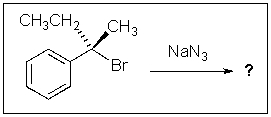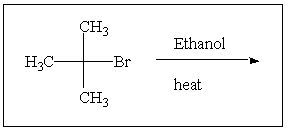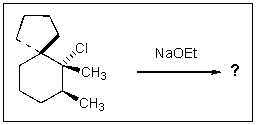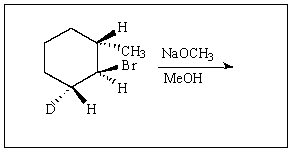A) A<B<C<D
B) A<C<B<D
C) C<A<B<D
D) A<C<D<B
E) None of the above.
Correct Answer

verified
Correct Answer
verified
Multiple Choice
The major product of the following reaction conditions will result from: 
A) SN2
B) SN1
C) E2
D) E1
E) there is no way to know
Correct Answer

verified
B
Correct Answer
verified
Multiple Choice
If the concentration of NaOH is doubled in the following reaction,what will happen to the reaction rate? 
A) no change
B) double
C) quadruple
D) cut in half
E) None of the above.
Correct Answer

verified
Correct Answer
verified
Multiple Choice
Solvolysis of 2-bromo-2-methylpropane occurs through what mechanism?
A) SN2
B) E1
C) E2
D) SN1
E) A and C
Correct Answer

verified
Correct Answer
verified
Multiple Choice
For the transformation of norepinephrine to epinephrine (adrenaline) ,what is the likely mechanism? 
A) SN1
B) SN2
C) E1
D) E2
E) both A and B are likely
Correct Answer

verified
Correct Answer
verified
Multiple Choice
Rank the following according to their increasing reactivity with water. 
A) CH3Br < CH3CH2Br < (CH3) 3CBr < ( CH3) 2CHBr
B) CH3Br < CH3CH2Br < ( CH3) 2CHBr < (CH3) 3CBr
C) (CH3) 3CBr < ( CH3) 2CHBr < CH3CH2Br < CH3Br
D) All of these will react with water at the same rate.
E) None of the above will react with water.
Correct Answer

verified
Correct Answer
verified
Multiple Choice
What would be the major organic product of the following reaction? 
A) ![]()
B) ![]()
C) ![]()
D) ![]()
E) ![]()
Correct Answer

verified
D
Correct Answer
verified
Multiple Choice
For the transformation below,give the structure of the starting material. 
A) ![]()
B) ![]()
C) ![]()
D) ![]()
E) ![]()
Correct Answer

verified
Correct Answer
verified
Multiple Choice
(S) -1-bromo-1-fluoroethane reacts with NaOMe to give: 
A) ![]()
B) ![]()
C) CH3CHFOCH3
D) CH3CHBrOCH3
E) CH3CH(OCH3) 2
Correct Answer

verified
Correct Answer
verified
Multiple Choice
To which side,if any,would the following equilibrium lie? (Do not consider any further reactions here.) 
A) to the left
B) to the right
C) equally to the right and left
D) there is no way to tell
E) this reaction cannot occur at all
Correct Answer

verified
Correct Answer
verified
Multiple Choice
Predict the major product of the following reaction: 
A) ![]() only
only
B) ![]()
C) ![]() only
only
D) ![]()
E) ![]() and
and![]()
Correct Answer

verified
Correct Answer
verified
Multiple Choice
Which of the following is the least nucleophilic base?
A) (CH3CH2) 3N
B) ![]()
C) ![]()
D) ![]()
E) ![]()
Correct Answer

verified
Correct Answer
verified
Multiple Choice
For the transformation below,give the structure of the starting material. 
A) ![]()
B) ![]()
C) ![]()
D) ![]()
E) Both B and C will provide the product shown.
Correct Answer

verified
Correct Answer
verified
Multiple Choice
Which mechanism proceeds with inversion of configuration?
A) bimolecular elimination (E2)
B) unimolecular elimination (E1)
C) unimolecular substitution (SN1)
D) bimolecular substitution (SN2)
E) free-radical halogenation
Correct Answer

verified
D
Correct Answer
verified
Multiple Choice
Indicate the expected major product of the following reaction: 
A) ![]()
B) ![]()
C) ![]()
D) ![]()
E) ![]()
Correct Answer

verified
Correct Answer
verified
Multiple Choice
Predict the product of reaction of the following deuterated compound. 
A) ![]()
B) ![]()
C) ![]()
D) ![]()
E) ![]()
Correct Answer

verified
Correct Answer
verified
Multiple Choice
Which would be true of the following reactions? 
A) cis would react faster
B) trans would react faster
C) cis and trans would react at the same rates
D) no reaction is expected under these conditions
E) the product shown would not be formed
Correct Answer

verified
Correct Answer
verified
Multiple Choice
Predict the major product of the following SN1 reaction: 
A) ![]()
B) ![]()
C) ![]()
D) ![]()
E) ![]()
Correct Answer

verified
Correct Answer
verified
Multiple Choice
Which of the following molecules will readily undergo an elimination reaction when treated with NaOCH3?
A) ![]()
B) ![]()
C) ![]()
D) ![]()
E) None of the above.
Correct Answer

verified
Correct Answer
verified
Multiple Choice
Which one of the following would undergo E2 elimination most rapidly?
A) ![]()
B) ![]()
C) ![]()
D) ![]()
E) All would react at the same rate.
Correct Answer

verified
Correct Answer
verified
Showing 1 - 20 of 25
Related Exams